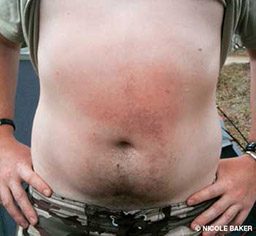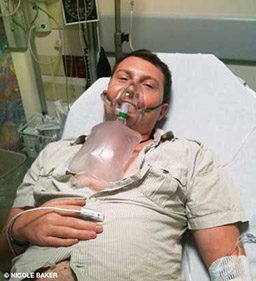On April 17, 2011, my boyfriend, Ben, and I took a trip to Key West to dive the USNS General Hoyt S. Vandenberg. We did two dives, both to about 90 feet, and we got some really cool photos of the radar dishes on the wreck’s top deck.

After the dives I noticed a large purple honeycomb-looking rash on Ben’s chest and stomach. I was concerned and asked him about it, but he brushed it off, saying it was from his new weight belt. While driving back to our campsite, I pushed him to call the DAN® Medical Information Line to get an expert’s opinion, but he continued to dismiss it as nothing serious.
Upon arrival at our campsite, Ben admitted that while he was driving he had been seeing stars, and he couldn’t read our campsite parking permit or the signs for the various islands we crossed on our drive back from Key West. I called the dive shop to ask for a recommendation. Neither of us had exceeded our computer’s limits, and we had dived the same dive profile, which included an extra half-depth safety stop. The shop recommended that if I was concerned about decompression sickness (DCS) we should go to the emergency room.
Next I called the DAN 24-Hour Emergency Hotline. DAN medical information specialist Dan Nord answered my call, and I was able to email him a photo of the rash. He reiterated the advice to go to the closest medical center.
Getting Treated
We arrived at the hospital, and after a lot of fussing about, consultation with DAN doctors, neurological exams and fluid administration (he received a total of 9 liters over the course of the stay), Ben was finally put on oxygen and advised to go to the nearest hyperbaric chamber for treatment. The treatment consisted of three hours spent compressed to 60 feet and another three hours at 30 feet. All the staff were very friendly and attentive, but I was perplexed by the initial delay in administering oxygen. If Ben had surfaced from a dive with these symptoms, I know the first priority would have been to put him on oxygen. That’s what DAN teaches in its oxygen-provider course. At the hospital, though, he received fluids and a neurological exam before the oxygen was administered.

Throughout all this, I was in contact with both DAN America, of which I am a member, and DAN Europe in Italy, of which Ben is a member. There were a host of administrative complications at the medical center. The time difference to Italy combined with the receptionist believing Ben’s DAN Europe card was an unacceptable form of European insurance made for a real headache. In the end, DAN America agreed to cover the expenses, and my understanding was that DAN Europe would repay them later. Both representatives of DAN with whom I spoke were very accommodating, pulling all kinds of tricks to make everything flow smoothly. Thank goodness for smartphones.
After the recompression treatment and an overnight stay in the hospital for observation, Ben was released. He was eventually diagnosed with DCS with neurological and cutaneous symptoms. The dive physician attributed the DCS to the somewhat aggressive, though not over-the-limit, dive profile, and he also believed dehydration may have been a contributing factor (we had been out on the town with some old friends the night before). I downloaded the profile from Ben’s dive computer and sent it to DAN as a contribution to their research efforts.
For months after the incident, we received bills for ambulance services (Ben had to make the 72-mile journey to the chamber with medical supervision), emergency room visits (from two hospitals) and the hyperbaric treatment. All I had to do was scan and email each bill to DAN, and the bills eventually stopped coming. I had never had a positive experience with a health insurance company before; it was so nice to feel like an insurance company was actually on our side.
There were no deductibles, and there was no fine print saying, “Well, actually, now that you mention it, we don’t cover this or that …,” and the caring nature of all the staff members with whom we spoke will ensure that we both renew our DAN memberships for the rest of our diving careers.
Err on the Side of Caution
I wanted to share this story as an example of how people should trust their instincts. I was pretty sure when I first saw Ben’s rash that it was a symptom of DCS, but for some reason there seems to be negative stigma associated with acknowledging that. If you think something isn’t right, don’t be afraid to admit it. Maybe it’s not DCS, but early recognition may improve the outcome. Delays can matter when it comes to effectiveness of treatment, severity of long-term symptoms and recovery time.
Also, recognize that not all health-care professionals you encounter will be familiar with dive medicine. Remember your own training, mentally review what you know about dive injuries, and don’t hesitate to involve DAN. I was caught off guard by the absence of a doctor trained in dive medicine at a medical center so close to a popular dive destination. Thanks, DAN, for making this experience as painless as possible for us, and keep up the good work.
© Alert Diver — Q1 Winter 2013